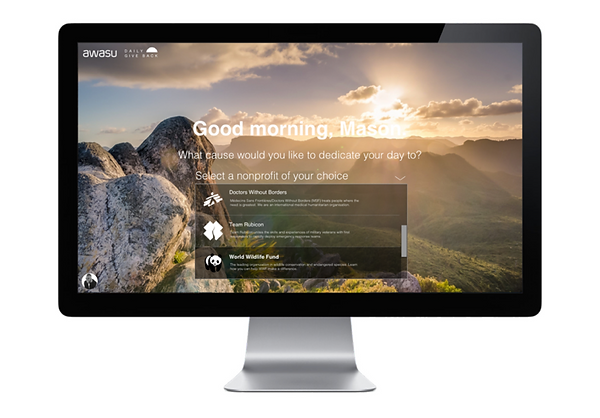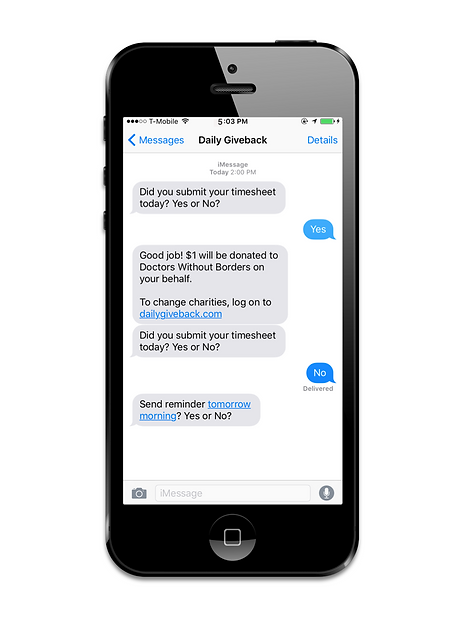Daily Giveback Productivity Tool
Our client was the CEO of a small design agency called Awasu Design. For the project, my partner Nick and I delivered a concept backed by user research insights and behavior design principles, and an interface design for the engineer to build as MVP. After the project, the client met with me to further explore an SMS chatbot idea I had during the ideation phase to pursue as the next phase.

The Problem
Employees often fail to complete their timesheet on time. It's burdensome for the employer to constantly remind them about it.
In order to bill the agency's clients for their projects, it's important that employees submit their timesheet, ideally on a daily basis so it's more accurate.
The Brief
The company would donate a dollar to the charity of the employee's choice for every on-time submission of their timesheet.
The client wanted a positive motivator that will get employees to want to submit their timesheet on time. This philanthropic element was driven by the client's wish to expand the company's social impact footprint.
We would not be designing a timesheet solution. They would still use their existing timesheet tracker called Harvest.
This tool could go beyond timesheet completion in the future, and be used for other employer-mandated tasks. It could be used for getting employees to complete their training, culture surveys, or paperwork for HR, for example.

MVP FLOW
The Research

Comparative Analysis
What we were looking for:
-
UI design that presented data and multiple choices in a simple, clean way
-
Gamification for motivation
-
Ways to visualize progress
-
Workplace incentivization tools
-
Charity donation platforms

Key Findings
Motivation is not the only problem with getting people to submit their timesheet.
We interviewed 6 people who either works or worked in professions required to submit time sheets. We quickly learned that it’s not easy to do for several reasons:
-
It's hard to remember, esp. at the end of the day
-
Input formats are not easy or flexible
-
It's cumbersome to do the math
-
There's little value or consequence directly affecting the individual
Personal gains, competition, visualizing progress, and emphasizing impact are more effective motivators than philanthropic donations.
As for charity donation as a motivator, people responded positively, and said that it created a positive feeling towards the company culture. However, when probed, charity donations alone weren't enough to keep them engaged on a daily basis.
MVP Design
NEW PROPOSED FLOW


Shifting Habits
People settle into their work in the morning with an idea of what they’ll work on that day. Instead of having time tracking be an afterthought at the end of the work day, we flipped it around to a mindful intent at the start of the day, with the message and tone focused on the philanthropic aspect. The employee is reminded that their timesheet submission will be doing good for a cause, by choosing a charity to dedicate their day to, it strengthens a sense of commitment and intention.

Gamification
We found that people were much more interested when presented with personal gains and visualized progress. There was especially high interest in the idea of earning points and redeeming for rewards such as extra vacation days or free lunches. Some were intrigued by badges for milestone achievements, and some reacted to leaderboard competition.
People also wanted to know their impact they’re making on the charities, the company’s impact as a whole, and what charities needed more help — these information made them feel more invested.
Phase 2: SMS Chatbot

Source: http://behaviormodel.org/
One of the things we researched was behavior design principles, because we were trying to get people make submitting their timesheet a habit. BJ Fogg's behavior model sums up the 3 criteria for successful habit formation. I just didn't think the MVP plugin solution sufficiently satisfied these criteria, which is why I came up with the chatbot idea.

Easy to do
SMS is something everyone has on their phone. It’s not a new site or app to visit. The input format is easy - just reply. The user can interact on-the-go, not constrained to being at a desktop.
Trigger
We learned that people don’t like being interrupted in their workflow, but with SMS notification, people didn't mind because they can choose to ignore it and come back to it later. People tolerated SMS interruptions more.
Motivation
Gamification such as competition, badge earning, and rewards redemption increases engagement. There will still be a webpage where people can log in to see their impact and progress.

SMS Chatbot
To start, the chatbot would solely be used for checking in only. User will get a reminder via SMS or Slack everyday, and confirm if timesheet has been submitted or not.
In the next phase, we’ll look into Harvest API integration (3rd party time sheet management software) to understand whether we can have users directly submit their time through SMS.

Web Interface
The user can log into a web interface to manage settings, view progress and stats, and redeem rewards with points.
Next Steps
Software engineer to look into available Harvest API to see if this solution is feasible.
Design a more robust version of the chatbot. How would the conversation go if the user can submit time directly via SMS? How will we identify project ID, how should the input format of time be so that it's easy for the user but also readable data that can be pushed into to Harvest?